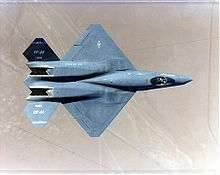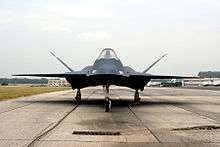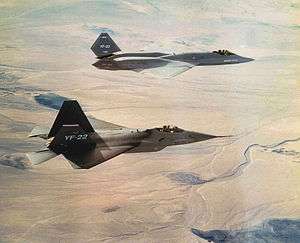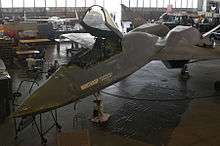Northrop YF-23
| YF-23 | |
|---|---|
 | |
| YF-23, nicknamed Gray Ghost (foreground), flying with YF-23 Black Widow II | |
| Role | Stealth fighter technology demonstrator |
| National origin | United States |
| Manufacturer | Northrop/McDonnell Douglas |
| First flight | 27 August 1990 |
| Status | Canceled |
| Primary user | United States Air Force |
| Produced | 1989–90 |
| Number built | 2 |
|
| |
The Northrop/McDonnell Douglas YF-23 was an American single-seat, twin-engine stealth fighter aircraft technology demonstrator designed for the United States Air Force (USAF). The design was a finalist in the USAF's Advanced Tactical Fighter (ATF) competition, battling the Lockheed YF-22 for a production contract. Two YF-23 prototypes were built with the nicknames "Black Widow II" and "Gray Ghost".
In the 1980s, the USAF began looking for a replacement for its fighter aircraft, especially to counter the USSR's advanced Sukhoi Su-27 and Mikoyan MiG-29. Several companies submitted design proposals; the USAF selected proposals from Northrop and Lockheed. Northrop teamed with McDonnell Douglas to develop the YF-23, while Lockheed, Boeing and General Dynamics developed the YF-22.
The YF-23 was stealthier and faster, but less agile than its competitor. After a four-year development and evaluation process, the YF-22 was announced the winner in 1991 and entered production as the Lockheed Martin F-22 Raptor. The U.S. Navy considered using the production version of the ATF as the basis for a replacement to the F-14, but these plans were later canceled. The two YF-23 prototypes were museum exhibits as of 2010.
Development
American reconnaissance satellites first spotted the advanced Soviet Su-27 and MiG-29 fighter prototypes in 1978, which caused concern in the U.S. Both Soviet models were expected to reduce the maneuverability advantage of contemporary US fighter aircraft.[1] In 1981, the USAF requested information from several aerospace companies on possible features for an Advanced Tactical Fighter (ATF) to replace the F-15 Eagle. After discussions with aerospace companies, the USAF made air-to-air combat the primary role for the ATF.[2] The ATF was to take advantage of emerging technologies, including composite materials, lightweight alloys, advanced flight-control systems, more powerful propulsion systems, and stealth technology.[3] In October 1985, the USAF issued a request for proposal (RFP) to several aircraft manufacturers. The RFP was modified in May 1986 to include evaluation of prototype air vehicles from the two finalists. At the same time, the U.S. Navy, under the Navalized Advanced Tactical Fighter (NATF) program, announced that it would use a derivative of the ATF winner to replace its F-14 Tomcat. The NATF program called for procurement of 546 aircraft along with the USAF's planned procurement of 750 aircraft.[4]

In July 1986, proposals were submitted by Lockheed, Boeing, General Dynamics, McDonnell Douglas, Northrop, Grumman and Rockwell. The latter two dropped out of competition shortly thereafter.[5] Following proposal submissions, Lockheed, Boeing, and General Dynamics formed a team to develop whichever of their proposed designs was selected, if any. Northrop and McDonnell Douglas formed a team with a similar agreement.[6] The Lockheed and Northrop proposals were selected as finalists on 31 October 1986. Both teams were given 50 months to build and flight-test their prototypes, and they were successful, producing the Lockheed YF-22 and the Northrop YF-23.[7]
The YF-23 was designed to meet USAF requirements for survivability, supercruise, stealth, and ease of maintenance.[8] Supercruise requirements called for prolonged supersonic flight without the use of afterburners.[9] Northrop drew on its experience with the B-2 Spirit and F/A-18 Hornet to reduce the model's susceptibility to radar and infrared detection.[10] The USAF initially required the aircraft to land and stop within 2,000 feet (610 m), which meant the use of thrust reversers on their engines. In 1987, the USAF changed the runway length requirement to 3,000 feet (914 m), so thrust reversers were no longer needed. This allowed the aircraft to have smaller engine nacelle housings. The nacelles were not downsized on the prototypes.[11][12]
The first YF-23 (serial number 87-0800), Prototype Air Vehicle 1 (PAV-1), was rolled out on 22 June 1990;[13] PAV-1 took its 50-minute maiden flight on 27 August with Alfred "Paul" Metz at the controls.[14] The second YF-23 (serial number 87-0801, PAV-2) made its first flight on 26 October, piloted by Jim Sandberg.[15] The first YF-23 was painted charcoal gray and was nicknamed "Spider"[15] and "Black Widow II", the latter after the Northrop P-61 Black Widow of World War II. It briefly had a red hourglass marking resembling the marking on the underside of the black widow spider before Northrop management had it removed.[16][17][N 1] The second prototype was painted in two shades of gray and nicknamed "Gray Ghost".[18]
Design

The YF-23 was an unconventional-looking aircraft, with diamond-shaped wings, a profile with substantial area-ruling to reduce aerodynamic drag at transonic speeds, and an all-moving V-tail. The cockpit was placed high, near the nose of the aircraft for good visibility for the pilot. The aircraft featured a tricycle landing gear configuration with a nose landing gear leg and two main landing gear legs. The weapons bay was placed on the underside of the fuselage between the nose and main landing gear.[19] The cockpit has a center stick and side throttle.[20]
It was powered by two turbofan engines with each in a separate engine nacelle with S-ducts, to shield engine axial compressors from radar waves, on either side of the aircraft's spine.[21] Of the two aircraft built, the first YF-23 (PAV-1) was fitted with Pratt & Whitney YF119 engines, while the second (PAV-2) was powered by General Electric YF120 engines. The aircraft featured fixed engine nozzles, instead of thrust vectoring nozzles as on the YF-22.[11] As on the B-2, the exhaust from the YF-23's engines flowed through troughs lined with heat-ablating tiles to dissipate heat and shield the engines from infrared homing (IR) missile detection from below.[10]
The flight control surfaces were controlled by a central management computer system. Raising the wing flaps and ailerons on one side and lowering them on the other provided roll. The V-tail fins were angled 50 degrees from the vertical. Pitch was mainly provided by rotating these V-tail fins in opposite directions so their front edges moved together or apart. Yaw was primarily supplied by rotating the tail fins in the same direction. Test pilot Paul Metz stated that the YF-23 had superior high angle of attack (AoA) performance compared to legacy aircraft.[22] Deflecting the wing flaps down and ailerons up on both sides simultaneously provided for aerodynamic braking.[23] To keep costs low despite the novel design, a number of "commercial off-the-shelf" components were used, including an F-15 nose wheel, F/A-18 main landing gear parts, and the forward cockpit components of the F-15E Strike Eagle.[10][15]
Operational history

Evaluation
The first YF-23, with Pratt & Whitney engines, supercruised at Mach 1.43 on 18 September 1990, while the second, with General Electric engines, reached Mach 1.6 on 29 November 1990. By comparison, the YF-22 achieved Mach 1.58 in supercruise.[24] The YF-23 was tested to a top speed of Mach 1.8 with afterburners and achieved a maximum angle-of-attack of 25°.[22] The maximum speed is classified, though sources state a maximum speed greater than Mach 2 at altitude and a supercruise speed greater than Mach 1.6.[25] The aircraft's weapons bay was configured for weapons launch, and used for testing weapons bay acoustics, but no missiles were fired; Lockheed fired AIM-9 Sidewinder and AIM-120 AMRAAM missiles successfully from its YF-22 demonstration aircraft. PAV-1 performed a fast-paced combat demonstration with six flights over a 10-hour period on 30 November 1990. Flight testing continued into December.[26] The two YF-23s flew 50 times for a total of 65.2 hours.[27] The tests demonstrated Northrop's predicted performance values for the YF-23.[28] The YF-23 was stealthier and faster, but the YF-22 was more agile.[29][30]
The two contractor teams submitted evaluation results with their proposals in December 1990,[28] and on 23 April 1991, Secretary of the Air Force Donald Rice announced that the YF-22 was the winner.[31] The Air Force selected the YF119 engine to power the F-22 production version. The Lockheed and Pratt & Whitney designs were rated higher on technical aspects, were considered lower risks, and were considered to have more effective program management.[31][32] It has been speculated in the aviation press that the YF-22 was also seen as more adaptable to the Navy's NATF, but by 1992 the U.S. Navy had abandoned NATF.[33][34]
Following the competition, both YF-23s were transferred to NASA's Dryden Flight Research Center at Edwards AFB, California, without their engines.[10][35] NASA planned to use one of the aircraft to study techniques for the calibration of predicted loads to measured flight results, but this did not take place.[35]
Possible revival
In 2004, Northrop Grumman proposed a YF-23-based bomber to meet a USAF need for an interim bomber, for which the FB-22 and B-1R were also competing.[36][37] Northrop modified aircraft PAV-2 to serve as a display model for its proposed interim bomber.[28] The possibility of a YF-23-based interim bomber ended with the 2006 Quadrennial Defense Review, which favored a long-range bomber with much greater range.[38][39] The USAF has since moved on to the Next-Generation Bomber program.[40]
Aircraft on display

Both YF-23 airframes remained in storage until mid-1996, when the aircraft were transferred to museums.[35]
- YF-23A PAV-1, Air Force serial number 87-0800, registration number N231YF, was on display as of 2015 in the Research and Development hangar of the National Museum of the United States Air Force near Dayton, Ohio.[41]
- YF-23A PAV-2, AF ser. no. 87-0801, registration number N232YF, was on exhibit at the Western Museum of Flight until 2004,[35] when it was reclaimed by Northrop Grumman and used as a display model for a YF-23-based bomber.[42] PAV-2 was returned to the Western Museum of Flight and was on display as of 2010 at the museum's new location at Torrance Airport, Torrance, California.[43]
Specifications (YF-23)

Data from Pace,[44] Sweetman,[45] Winchester,[10] Aronstein,[25]
General characteristics
- Crew: 1 (pilot)
- Length: 67 ft 5 in (20.60 m)
- Wingspan: 43 ft 7 in (13.30 m)
- Height: 13 ft 11 in (4.30 m)
- Wing area: 900 ft2 (88 m2)
- Empty weight: 29,000 lb (13,100 kg)
- Loaded weight: 51,320 lb (23,327 kg)
- Max. takeoff weight: 62,000 lb (29,000 kg)
- Powerplant: 2 × Pratt & Whitney YF119 or General Electric YF120 afterburning turbofan, 35,000 lbf (156 kN) each
Performance
- Maximum speed:
- At altitude: Mach 2.2+ (1,450+ mph, 2,335+ km/h)
- Supercruise: Mach 1.6+ (1,060+ mph, 1,706+ km/h)
- Range: over 2,790 mi (over 4,500 km)
- Combat radius: 750–800 nmi (865–920 mi, 1,380–1480 km)
- Service ceiling: 65,000 ft (19,800 m)
- Wing loading: 54 lb/ft2 (265 kg/m2)
- Thrust/weight: 1.36
Armament
None as tested but provisions made for:[10]
- 1 × 20 mm (0.79 in) M61 Vulcan cannon
- 4 × AIM-120 AMRAAM or AIM-7 Sparrow medium-range air-to-air missiles[10][46]
- 2 × AIM-9 Sidewinder short-range air-to-air missiles[46]
See also
- Aircraft of comparable role, configuration and era
- Related lists
References
Notes
Citations
- ↑ Rich, Michael and William Stanley. Improving U.S. Air Force Readiness and Sustainability. Rand Publications, April 1984. p. 7.
- ↑ Sweetman 1991, pp. 10–13.
- ↑ Miller 2005, p. 11.
- ↑ Williams 2002, p. 5.
- ↑ Miller 2005, pp. 13–14, 19.
- ↑ Goodall 1992, p. 94.
- ↑ Jenkins and Landis 2008, pp. 233–34.
- ↑ "ATF procurement launches new era". Flight International, 15 November 1986. p. 10. Retrieved 25 June 2011.
- ↑ Goodall 1992, p. 91.
- 1 2 3 4 5 6 7 Winchester 2005, pp. 198–99.
- 1 2 Miller 2005, p. 23.
- ↑ Sweetman 1991, pp. 23, 43.
- ↑ "YF-23 roll out marks ATF debut." Flight International, 27 June – 3 July 1990. p. 5. Retrieved 24 June 2011.
- ↑ Goodall 1992, p. 99.
- 1 2 3 Jenkins and Landis 2008, p. 237.
- 1 2 Goodall 1992, p. 120.
- 1 2 Miller 2005, p. 37.
- ↑ Pace 1999, p. 50c.
- ↑ Goodall 1992, pp. 108–15, 124.
- ↑ Walkaround. yf-23.net
- ↑ Sweetman 1991, pp. 42–44, 55.
- 1 2 "YF-23 would undergo subtle changes if it wins competition". Defense Daily 14 January 1991
- ↑ Sweetman 1991, pp. 34–35, 43–45.
- ↑ Goodall 1992, pp. 102–103.
- 1 2 Aronstein 1998, p. 136.
- ↑ Miller 2005, pp. 36, 39.
- ↑ Norris, Guy. "NASA could rescue redundant YF-23s." Flight International, 5–11 June 1991. p. 16. Retrieved: 25 June 2011.
- 1 2 3 Miller 2005, pp. 38–39.
- ↑ Goodall 1992, p. 110.
- ↑ Sweetman 1991, p. 55.
- 1 2 Jenkins and Landis 2008, p. 234.
- ↑ Miller 2005, p. 38.
- ↑ Miller 2005, p. 76.
- ↑ Williams 2002, p. 6.
- 1 2 3 4 "YF-23." NASA Dryden Flight Research Center, 20 January 1996. Retrieved: 25 June 2011.
- ↑ Hebert, Adam J. "Long-Range Strike in a Hurry." Air Force magazine, November 2004. Retrieved: 24 June 2011.
- ↑ "YF-23 re-emerges for surprise bid". Flight International, 13 July 2004.
- ↑ "Quadrennial Defense Review Report." U.S. Department of Defense, 6 February 2006. Retrieved 25 June 2011.
- ↑ Hebert, Adam J. "The 2018 Bomber and Its Friends." Air Force magazine, October 2006. Retrieved 24 June 2011.
- ↑ Majumdar, Dave. "U.S. Air Force May Buy 175 Bombers." Defense News, 23 January 2011. Retrieved 29 August 2011.
- ↑ "Northrop-McDonnell Douglas YF-23A Black Widow II". National Museum of the U.S. Air Force, 6 November 2015. Retrieved 27 February 2016.
- ↑ Miller 2005, p. 39.
- ↑ "Static Displays"; "Northrop YF-23A 'Black Widow II'". Western Museum of Flight. Retrieved 31 August 2011.
- ↑ Pace 1999, pp. 14–15.
- ↑ Sweetman 1991, p. 93.
- 1 2 Sweetman 1991, pp. 42–43.
Bibliography
- Aronstein, David C. and Michael J. Hirschberg. Advanced Tactical Fighter to F-22 Raptor: Origins of the 21st Century Air Dominance Fighter. Arlington, Virginia: AIAA (American Institute of Aeronautics & Astronautics), 1998. ISBN 978-1-56347-282-4.
- Goodall, James C. "The Lockheed YF-22 and Northrop YF-23 Advanced Tactical Fighters". America's Stealth Fighters and Bombers, B-2, F-117, YF-22, and YF-23. St. Paul, Minnesota: Motorbooks International Publishing, 1992. ISBN 0-87938-609-6.
- Jenkins, Dennis R. and Tony R. Landis. Experimental & Prototype U.S. Air Force Jet Fighters. North Branch, Minnesota: Specialty Press, 2008. ISBN 978-1-58007-111-6.
- Miller, Jay. Lockheed Martin F/A-22 Raptor, Stealth Fighter. Hinckley, UK: Midland Publishing, 2005. ISBN 1-85780-158-X.
- Pace, Steve. F-22 Raptor. New York: McGraw-Hill, 1999. ISBN 0-07-134271-0.
- Sweetman, Bill. YF-22 and YF-23 Advanced Tactical Fighters. St. Paul, Minnesota: Motorbooks International Publishing, 1991. ISBN 0-87938-505-7.
- Williams, Mel, ed. "Lockheed Martin F-22A Raptor", Superfighters: The Next Generation of Combat Aircraft. London: AIRtime Publishing, 2002. ISBN 1-880588-53-6.
- Winchester, Jim, ed. "Northrop/McDonnell Douglas YF-23", Concept Aircraft. Rochester, Kent, UK: Grange Books, 2005. ISBN 1-84013-809-2.
External links
| Wikimedia Commons has media related to Northrop YF-23. |
- YF-23 photos on DFRC/NASA site
- "YF-23 Black Widow II, Declassified: Web of Secrecy" - documentary film (2000)
- Northrop/McDonnell Douglas YF-23 page on Joe Baugher's site
- YF-23 "Black Widow II", Northrop/McDonnell Douglas page on fighter-planes.com
- YF-23 Enthusiast's Site, includes details about post-cancellation
